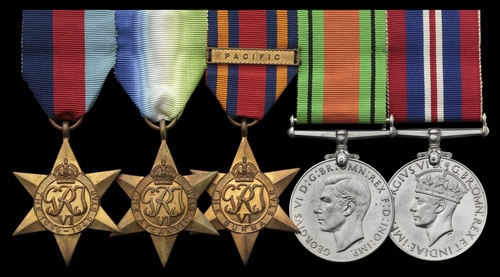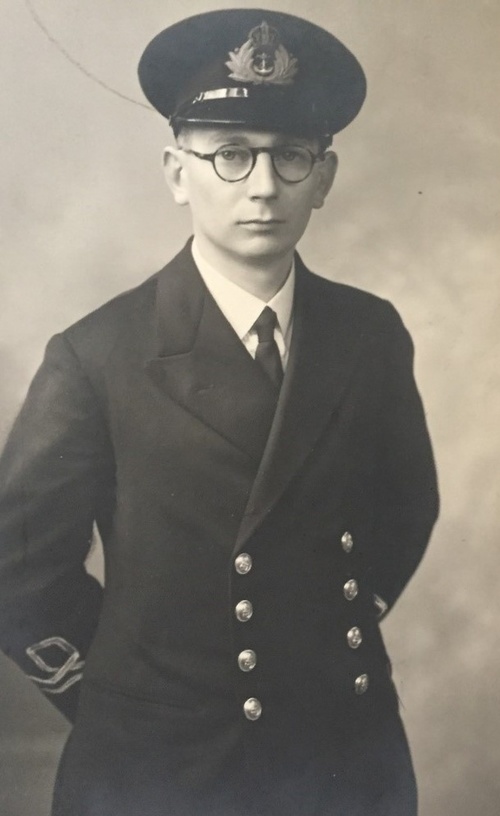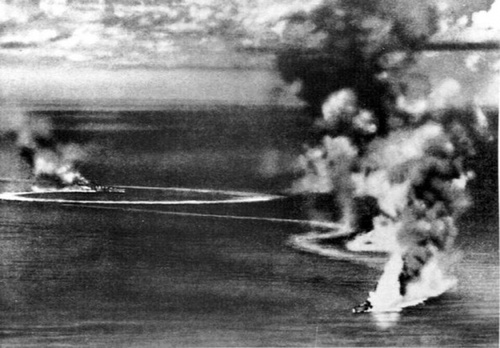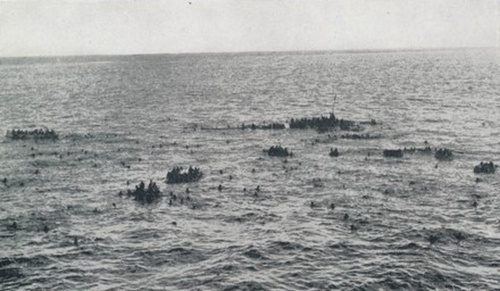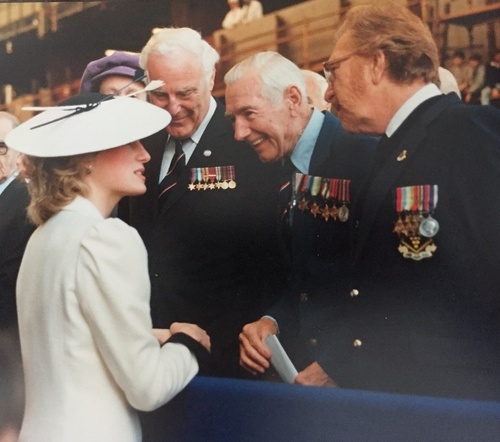Auction: 22003 - Orders, Decorations and Medals
Lot: 398
APRIL 1942: TRAGEDY OFF CEYLON
'Once in the water I was covered in thick fuel oil (which has a consistency of black treacle) which meant that I could only open my eyelids a small amount … I then came alongside Sub-Lieutenant (E.) Dougall, a Royal Canadian Naval Volunteer Reserve, who was with us for training, and he got a lifebelt off one of the corpses and helped me get it on - not an easy job with both of us covered in oil and swimming in an oil covered sea - I never saw him again. We were then subjected to machine-gun fire from the large number of Japanese planes that hung around until the ship sank …
I found myself alone and conscious of dead bodies, large fish and wreckage. I found a messdeck tabletop, about 3ft wide and 10ft long, and was thankful for a rest as I clung to it; it was not possible to get on it. The ship's Physical Training Petty Officer came swimming by heading for the motorboat we could see in the distance - he suggested that I should accompany him. I said that I would follow him because he was a more powerful swimmer. No sooner had I left my table than I trod on a large fish - I was soon back on my table! However, I worked out that because it gets dark about 7 p.m. if I did not reach the motorboat before then, I was going to be on my own all night. So I summoned up courage and eventually reached the motorboat just as darkness fell.
I reported to Commander Fair who was in the motorboat and he put me in charge of one of the Carley floats which were all roped together around the motorboat. There were already over 20 ratings standing in my float which meant that the buoyant 'sausage' from which the wooden centre is suspended was 2ft below water level, so it looked as if we were all standing with the water at about waist level! The waters of the Indian Ocean are very clear and as we stood in our Carley float and looked down, the large sharks were clearly visible below … '
Lieutenant (E.) E. A. 'Ted' Drew, R.N., recalls the tragic events of 5 April 1942, when H.M.S. Cornwall was sunk by Japanese dive-bombers off Ceylon.
A documented Second World War campaign group of five awarded to Electrical Lieutenant N. P. Rice, Royal Naval Volunteer Reserve, who survived the loss of H.M.S. Cornwall to Japanese aircraft off Ceylon on 5 April 1942
Amidst harrowing scenes Cornwall's survivors - in common with those from the Dorsetshire, sunk on the same occasion - endured merciless Japanese machine-gun attacks and the attention of plenty of sharks: it would take 30 hours before they were rescued, by which time over 400 men had died
This, then, just one episode in what became known as the 'Easter Sunday Raid', a raid mounted against Ceylon by Japanese cruisers and carriers to match the infamous attack on Pearl Harbour
In his subsequent capacity as President of the H.M.S. Cornwall Association, Rice was presented to Diana, H.R.H. the Princess of Wales, at the launch of the Type 22 frigate H.M.S. Cornwall at Yarrow's yards in Glasgow in October 1985
1939-45 Star; Atlantic Star; Burma Star, clasp, Pacific; Defence and War Medals 1939-45, mounted as worn, together with his related miniature dress medals and H.M.S. Cornwall Association lapel badge, good very fine (11)
Norman Richard Rice was born in East Dulwich, in south-east London on 15 January 1913 and was appointed a Temporary Electrical Sub. Lieutenant in the Royal Naval Volunteer Reserve in September 1939.
He subsequently joined the heavy cruiser H.M.S. Cornwall and was likewise employed at the time of her loss to Japanese aircraft in April 1942.
The Easter Day Raid
On 4 April 1942, having recently been assigned to Force A of the Eastern Fleet, Cornwall, commanded by Captain P. C. W. Manwaring, R.N., and Dorsetshire, commanded by Captain A. W. S. Agar, V.C., D.S.O., R.N., left Columbo to intercept two Japanese cruisers. The following day, the Japanese launched what became known as the Easter Day Raid, waves of Aichi D3A dive-bombers - known as 'Vals' to the Allies - taking off from three carriers and inflicting major damage on Colombo.
Just as the attack on Colombo was ending a Japanese reconnaissance floatplane from the cruiser Tone reported the position of the Cornwall and Dorsetshire, following which Admiral Nagumo ordered his remaining dive-bombers to intervene.
Thus, at 1.40 p.m. on the 5th, nearly 80 'Vals' dived to the attack, Cornwall taking a direct hit and two near misses on their first run. Dorsetshire also took a hit, which damaged her steering gear, sending her in an uncontrollable circle. Then she received four further hits and, just eight minutes after the attack had commenced, she sank by the stern.
Cornwall's fate was also sealed, for in ensuing strikes the 'Vals' achieved seven further hits, causing considerable damage - the after engine-room and both boiler rooms were flooded, and electrical power was disrupted. Moreover, the forward engine-room took a direct hit, as did the ship's sick bay. At 1.58 p.m., Captain Manwaring gave the order to abandon ship, and the Cornwall capsized just four minutes later.
Having then been machine-gunned in the water, survivors from both ships clung to wreckage and rafts in the shark-infested waters of the Indian Ocean for a period of 30 hours, one of the most harrowing ordeals on record.
A compelling description of that suffering is to be found in an account left by Cornwall's Lieutenant (E.) E. A. 'Ted' Drew, R.N., see:
https://www.world-war.co.uk/cornwall_loss.php
Succour finally arrived in the form of H.M. Ships Enterprise, Paladin and Panther, at 1800 hours on 6 April 1942. By then, the two cruisers had sustained a loss in excess of 400 men.
Following Cornwall's sinking, Rice served at Cape Town, South Africa, prior to returning to various appointments in the U.K. He was released from the R.N.V.R. in the rank of Electrical Lieutenant at the war's end.
Postscript
In the post-war era, Rice served as President of the H.M.S. Cornwall 1939-42 Association, one memorable event being a reunion with survivors from the Pinguin, organised to mark the 40th anniversary of the German auxiliary cruiser's loss to Cornwall's guns in May 1941.
Perhaps most memorable of all, however, was his attendance at the launch of the Type 22 frigate H.M.S. Cornwall at Yarrows in Glasgow in October 1985, when he and his fellow veterans were presented to Diana, H.R.H. the Princess of Wales. He also attended Cornwall's commissioning at Falmouth in April 1988.
Rice died in April 1995.
Sold with the following original documentation:
(i)
A letter from the Admiralty, Bath, forwarding lengths of riband for the 1939-45 and War Medal, addressed to 'Elec. Lieut. N. R. Rice, R.N.V.R.', with related envelope.
(ii)
His wartime identity disc.
(iii)
A wartime portrait photograph, in R.N.V.R. uniform.
(iv)
A presentation certificate from surviving veterans of the German cruiser Pinguin, inscribed to 'Herrn Norbert Rice', dated at Lütjenburg on 8 May 1981; together with a quantity of related photographs.
(v)
Assorted correspondence, invitations, commemorative pamphlets and photographs in respect of the launch and commissioning ceremonies for the Type 22 frigate H.M.S. Cornwall in 1985 and 1988, including a copy of the ship's commissioning book, black binding, gilt titles.
Subject to 20% VAT on Buyer’s Premium. For more information please view Terms and Conditions for Buyers.
Sold for
£300
Starting price
£130

